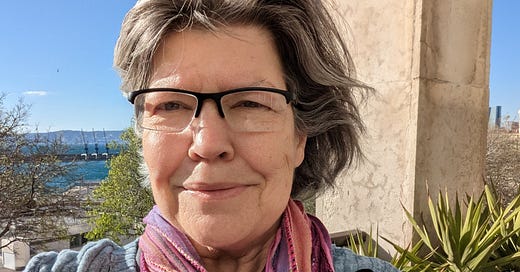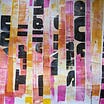Hello beautiful human,
I have been friend, colleague, collaborator and co-conspirator with Wendy Vardaman for fifteen or more years. It’s hard to find words that adequately describe a friendship, partnership, and mutual back-and-forthing of ideas, projects and life events across years. If I wanted to, I could write a book (or better yet, we’d create it together), a full-length book, off the top of my head of the adventures and projects we’ve participated in together. The many conversations driving across the state of Wisconsin to one event or conference or another. Often getting somewhat lost along the way.
I’ll just share with you one helpful thing she said a long time ago, that I’ve never forgotten. “Poems are like goldfish,” she told me with a smile. “You have to let them go and just not worry too much. Focus on the next one. Catch and release.”
I pass along that pearl to you today, especially for those of us who are writing, painting, stitching, or making in some other way. Do the thing, do it as well as you can, and let it go. Turn to the next thing. Don’t grow too attached.
That focus on process, rather than end product, is a hallmark of Wendy’s praxis and today in the Practice Sessions she shares more of that mindset with us. I’m so grateful and glad to introduce Wendy here. And now in her own words…
Here’s one of those short, official bios I send out with writing submissions. A slightly longer version is on my website, along with a lot of images of book projects I’ve been involved with as a writer, designer, and illustrator, and some links to poems, essays, and interviews that I’ve written:
Wendy Vardaman (wendyvardaman.com), PhD, lives in Madison, WI, and works as a web & digital media specialist. She is the author of Obstructed View (2009), Reliquary of Debt (2015), a collaborative chapbook with Sarah Sadie, Rules of (dis)engagement, or Dubious perFormances (2016), and a forthcoming chapbook, thread me an exit. With Sarah Sadie she published Verse Wisconsin, created a micro-press, co-edited two anthologies, and served as Madison poets laureate from 2012 to 2015. In addition to poetry, her creative practice includes editing, prose writing, illustration, printmaking, and design. She volunteers for arts and social justice causes as a designer, artist, and editor.
There’s a lot that bio leaves out, however.
Once upon a time I threw myself into motherhood, poetry, working out, and catholicism. I turned out to be a lot less good at these things than I imagined, and they imploded together around 2016, though the cracks were showing before then. Before then I did mostly volunteer work (tons of it) for 20 years beginning when I quit my one-and-only teaching job at a university (short-lived–I couldn’t keep my head above water, and I wasn’t good at teaching either). I also wrote a lot of poetry and a lot of prose about poetry.
In 2015 I went back to school to study graphic and web design, finished quitting the volunteer work, and got a job (first copyediting, now managing web sites & visualizing data) with a trade association in the building industry. It helped pay the bills–sizable with three kids going to college. I thought maybe I was done writing, and I hoped to find a job as a designer/artist eventually. Call it a menopausal crisis. I wrote like crazy until 2015. Then the words disappeared. I had nothing to say, and trying so hard to say nothing wasn’t any fun.
Between 2016 and now I did a lot of deferred traveling, sometimes with others & sometimes alone; took lots of art classes; learned to letterpress; got an internship in a science lab as an illustrator/designer; stopped being able to walk normally, let alone run; moved my mother four times through her decline/ dementia; became estranged from one of three children; traded catholicism for meditation and buddhism; realized art was more of a hobby than a vocation; found a way back to words and to working out; started writing poem-enough-like things and submitting work again after a long time away.
The Five Questions for the Practice Sessions
What are your current fascinations?
color (as always), texture, visualizing data (not just numbers) & trying to apply that to poetry, gaps, reinvention, training a rescue dog with serious anxiety (not something I pictured doing with myself this year), women artists, book making, the creative process.
What does a “delicious day” consist of, for you?
Not sure I’d use the word delicious, but a day that feels satisfying includes sleeping as long as I like but not too late, making coffee, staring out the window with my art journal/poem page/writing journal, meditating, walking, working on a poetry project (manuscript or essay), exercising/moving, seeing a friend in there somewhere, having dinner with my husband/son who lives at home, playing a board game, reading a book instead of scrolling my phone.
How do you take care of yourself?
All of the above–the combination of creative work, meditation, movement, spending time with family/ friends, regulating screen time outside of work (which is all screen time), working less than full-time, eating healthy food, getting support from a therapist, acupuncture, going to the gym, recognizing my limits and being kind to myself about them.
We are the stories we tell. I’m curious if, at this point, you sense yourself moving into any new stories, or if there are stories you feel you’re recovering?
I’m definitely recovering the story of myself as a writer and creator. I’ve moved away from the story of me as a daughter/mother/caretaker, though that story still has a powerful hold. I’m trying to tell myself a story about aging positively with a sense of hope, curiosity, acceptance, adaptability, compassion for self/others, and continual learning. I’m also working on my imposter syndrome narrative and trying to tell myself something more functional as a creative–it’s a work in progress.
I started answering these questions in December in a different epoch and a different country. I was lucky enough to start an 18-day artist residency at Ragdale on January 20. Sometimes in a crisis, you realize what's most important to try and salvage. I felt such a yearning for collaboration there as well as conversation about creative work and respect for artists who worked to lift each other up. This is the kind of work Sarah & I did together--what she says she could write "a full-length book, off the top of my head" about, and I believe her!
Sarah recently also mentioned in this blog that we are learning to be in conversation and community again with each other. I shared that thought with the other residents one evening as we gathered for an impromptu conversation around our shifting landscape. What questions did we have? What did we need to move forward with our work? A whole vocabulary that I co-developed with Sarah came rushing back to me, as we discussed systems of artistic production, the gift economy, diy, and the value, the absolute unnegotiable value, of the spiritual and of the beloved community to our work. And suddenly, I was not alone, and that felt so important, and much more so than any specific "work" I accomplished while there. I'm currently working on Part Two of the "Poetics of Hope" essay that Sarah is sharing with you, moving into some old stories that I held about creativity, community, and spacious attention. I lost sight of those values during the last eight years, but now they're a lifeboat.
Let’s include a gratitude you’d like to share with us…a person, or a place, or something you’d like to express gratitude for who has helped you arrive at this moment.
I’m especially grateful to the women–friends & mentors–not always writers, who’ve been part of my journey.
Wendy mentioned that a good day includes turning away from her phone and screens and reading a book. She’s given us some recommendations at Baker’s Dozen Books, with wonderful descriptions for each.
Find many practices shared generously below in Wendy’s essay, “the poetics of hope” and maybe the very first place to start is simply appreciating the way she puts text and visual art right next to each other. When was the last time you mixed it up?










